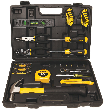What is a carbon footprint? Simply put, anything that you do during the course of your normal daily routine that produces carbon dioxide and other harmful gasses to contribute to the Greenhouse Effect leaves behind your own footprint—a carbon footprint, if you will.
Some of the things we do each day add up to large carbon residuals. Using gas-powered machines such as cars, lawn mowers, garden tillers, motorcycles, and generators leaves carbon behind. Using electric appliances such as dishwashers, clothes washers, ovens, clothes dryers, refrigerators, freezers, hair dryers, televisions, computers, and microwave ovens, and even something as simple as turning on a light leaves a carbon footprint. Using water to wash clothes and dishes, water lawns, personal bathing, swimming pools, water gardens, and brushing your teeth uses energy to leave behind carbon.
But, certainly, you aren't the only one performing those activities. If it were only you, then there wouldn't be a problem. But everyone else performs those same activities and, when you combine the billions of people all of the world doing the same activities that you do each day, that adds up to one gigantic carbon footprint, and the Earth bears the brunt of that footprint.
Perhaps it's time to understand and assess the carbon footprint that you leave behind. There are two types of carbon footprints; primary and secondary. Primary footprints are all of the things that we do each day to use energy, such as those things described above. But secondary footprints are a bit more complex, resulting from a chain of events. For example, if you use bottled water instead of water from the tap, you are leaving behind a secondary carbon footprint. You drive to the store in your car, to buy the water that was produced at a plant using electricity and machinery to mold the plastic bottle and label it, which in turn had to hire a truck to drive the product to the store to place it on the shelves of the store, which in turn had to use electricity to light the store so that you could see the product, and the list goes on and on. That secondary footprint could have been avoided if only you would have turned on your tap at home to get a drink of water. It's that simple.
Use online carbon footprint calculators to assess your individual carbon footprint. There are several available online. Simply type the words carbon footprint calculator into any search engine, and take the assessment. Even if your carbon footprint is low, there are still things that you can do to leave behind a smaller footprint. You might even aim to be carbon neutral, reducing your greenhouse emissions to zero.

Find the Right Tool Right Away Finally, a homeowner's set that includes all the tools needed to complete basic DIY projects at an affordable price! The tools are stored in a molded case for security and portability. Check out Stanley 65-Piece Homeowner's Tool Kit today!
If you want to stretch your energy dollar even farther, place your CFLs on a dimmer, timer, or motion sensor switch. That ...
Discover MoreIn today's economy, who doesn't want to have a little extra money lying around? One of the best ways that you can do that ...
Discover MoreWeatherproofing your home is an important task, regardless of what the weather may currently look like. Surprisingly, ...
Discover MoreThere are currently no comments for this tip. (Be the first to leave your comment—just use the simple form above!)
Copyright © 2025 Sharon Parq Associates, Inc.
Comments